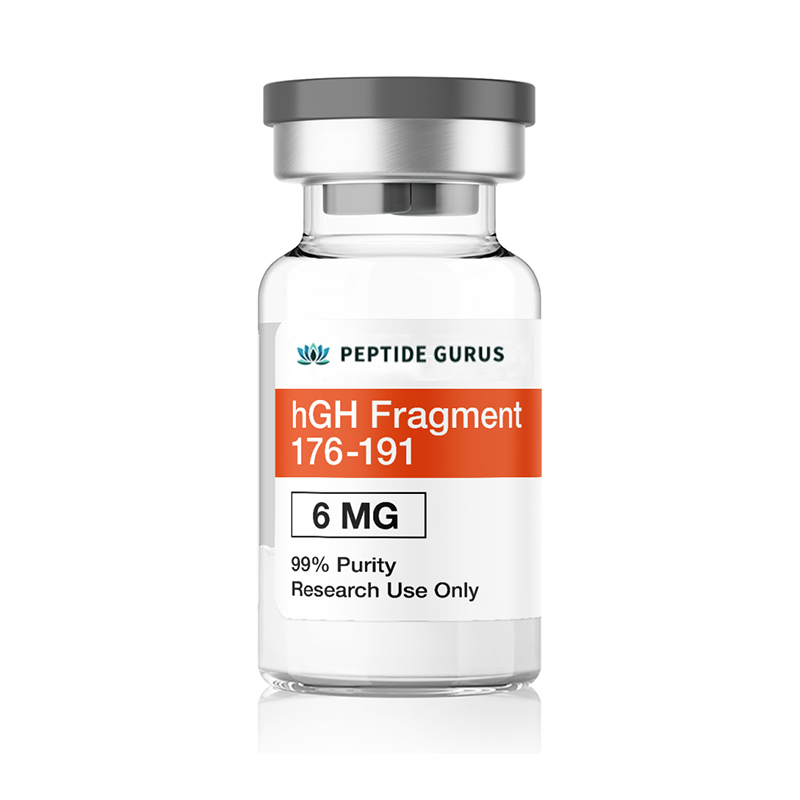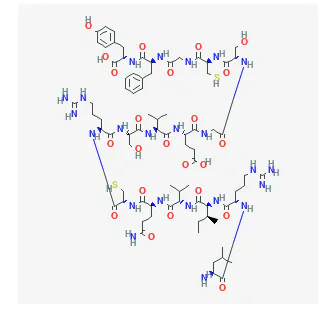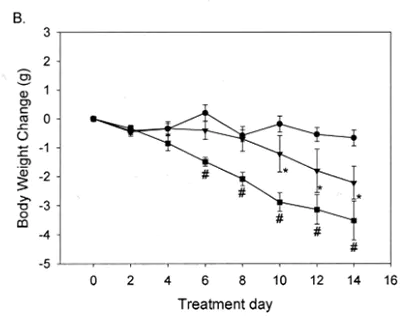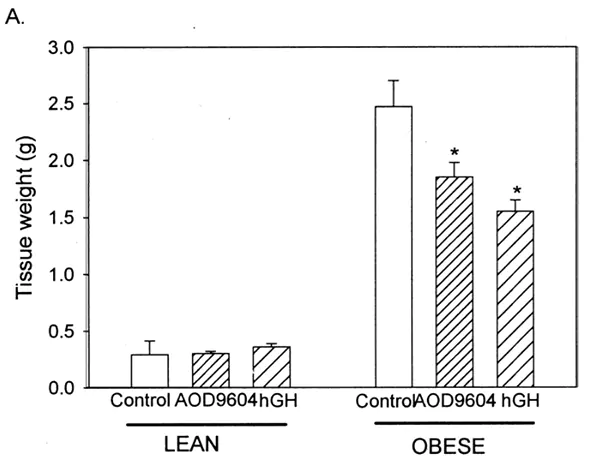



Kategorien:Peptid-Fertigprodukt, Peptide und ihre Dosierungen
Freies (1) 30 ml bakteriostatisches Wasser
mit qualifizierten Bestellungen über$ 500 USD.
(Ausgeschlossene Kapselprodukte, kosmetische Peptide, Promo -Codes und Versand)
HGH-Fragment 176-191ist ein kleines, synthetisches Stück natürliches menschliches Wachstumshormon (HGH). Es wird oft als „lipolytisches Fragment“ bezeichnet, um den Fettabbau zu steigern. Es wurde gezeigt, dass es dazu beiträgt, den Blutzuckerspiegel zu senken und die Knorpelheilung zu fördern, ohne das lange Knochenwachstum zu erhöhen, den IGF-1-Spiegel zu erhöhen oder die Insulinsensitivität zu verändern.
Produktnutzung:Dieses Produkt ist nur als Forschungschemikalie gedacht.Diese Bezeichnung ermöglicht die Verwendung von Forschungschemikalien ausschließlich für In -vitro -Tests und Laborversuche. Alle auf dieser Website verfügbaren Produktinformationen dienen nur zu Bildungszwecken. Die körperliche Einführung jeglicher Art in Menschen oder Tiere ist gesetzlich streng verboten. Dieses Produkt sollte nur von lizenzierten, qualifizierten Fachleuten behandelt werden. Dieses Produkt ist keine Droge, Nahrung oder Kosmetik und darf als Medikament, Nahrung oder Kosmetik nicht missbraucht, missbraucht oder missbräuchlich werden.
Das Fragment 176-191 (modifizierte Version von AOD9604) ist ein kleines Stück des Wachstumshormons (HGH), das manchmal als „lipolytisches Fragment“ bezeichnet wird. Das Fragment 176-191 erhielt diesen letzteren Namen, da die Laborforschung gezeigt hat, dass es die Fettverbrennung verbessert, insbesondere bei Mäusen, die genetisch zur Herstellung großer Fettgeschäfte entwickelt wurden. Das Fragment 176-191 wurde in Tiermodellen stark untersucht, da es, obwohl es die Fettverbrennungseffekte von HGH bewahrt, einige andere Auswirkungen seines Elternproteins wie Erhöhung des Insulin-ähnlichen Wachstumsfaktors-1 (IGF-1), das negative Auswirkungen auf den Kohlenhydrat-Metabolismus, die Veränderung des Insulinsensitivität, das Erhöhen des Langknochenwachstums und so so weiter vermeidet. Die gezielten Auswirkungen von Fragment 176-191 machen es nützlich, um den menschlichen Fettstoffwechsel zu untersuchen, und bilden möglicherweise die Grundlage für die Entwicklung von Medikamenten gegen die Zubehör.

Quelle:PubChem
Sequenz:Tyr-Leu-Arg-Ile-Val-Gln-Cys-Arg-Ser-Val-Glu-Gly-Ser-Cys-Gly-Phe
Molekülformel:C78H125N23O23S2
Molekulargewicht:1817.12 g/mol
CAS -Nummer:66004-57-7
Die Forschung an Tieren hat gezeigt, dass das C-terminale Ende von HGH hauptsächlich für die hypoglykämischen (sensibler Blutzucker) des Proteins verantwortlich ist. Das Testen von mindestens sechs verschiedenen Fragmenten, die aus diesem Abschnitt von HGH stammen, hat gezeigt, dass Fragment 176-191 das effektivste synthetische Derivat von HGH zur Senkung des Blutzuckerspiegels ist. Dieser Effekt ist sekundär zu einem anhaltenden Anstieg des Plasma -Insulinspiegels[1]. There is some interest in using fragment 176-191 as a treatment for both prediabetes and type 2 diabetes.
Fragment 176-191 has earned the nickname of “lipolytic fragment” because testing in mice has revealed the peptide to have substantial fat burning and weight loss properties. It is thought that this action is mediated through an increase in production of beta-3 adrenergic receptors (β3-AR or ADRB3)[2]. Agonist action at ADRB3 is known to directly increase fat burning in adipose tissue and is also responsible for thermogenesis in skeletal muscle[3]. Mice that have been genetically modified to produce no ADRB3 do not respond to the lipolytic effects of hGH or fragment 176-191[2].
Studies show that the increased fat burning associated with fragment 176-191 directly correlates with energy expenditure and thus weight reduction, leading to a nearly 50% reduction in weight gain in obese animals over a three-week course[4]. Interestingly, the weight loss effects were seen only in obese mice, with lean mice maintaining normal body weight, on average, even when exposed to fragment 176-191[2]. These findings indicate that there are secondary regulatory pathways for lipolysis that override ADRB3 function when body weight is at or near ideal, opening up areas for additional research into energy homeostasis.

Body weight in genetically obese mice after two weeks of treatment with a single daily dose of fragment 176-191
Source: Oxford Academic

Effect of saline (control), fragment 176-191, and hGH on white adipose tissue mass in obese mice over 14 days
Source: Oxford Academic
Though fragment 176-191 is primarily of interest for its lipolytic properties, the peptide is under investigation for other possible benefits. Of note, a 2015 article out of Korea revealed that fragment 176-191 may be able to potentiate the effects of hyaluronic acid injections in promoting cartilage regeneration. Studies in rabbits indicated that weekly injections of fragment 176-191 increase laboratory measures of cartilage growth and that co-administration of the peptide with hyaluronic acid (HA) produces even more substantial effects. Similarly, the study found that fragment 176-191, both alone and in combination with HA, reduces disability associated with osteoarthritis. There is hope that this may lead to advanced therapies for osteoarthritis and may even eliminate the need for surgery in certain settings[7].
There is some concern that the use of hGH or its derivatives for weight control may have unwanted side effects. This concern arises from the fact that studies of hGH have shown that long-term exogenous administration, while increasing lean body mass and decreasing adipose tissue, can also cause:
In 2013, a study published in the Journal of Endocrinology and Metabolism evaluated six studies of fragment 176-191 to assess the rate and significance of negative effects associated with the peptide. The study, included only research that followed the randomized, double-blinded, placebo-controlled model of a phase IIb clinical trial in order to keep the highest possible standards of evidence. It found that IV and oral administration of Fragment 176-191, when compared to placebo, led to no changes in:
The results of this meta-analysis suggest that fragment 176-191 offers many of the benefits of hGH without the associated negative (and often serious) side effects. These findings further the argument for pursuing regulatory approval for use of fragment 176-191 in the clinical setting, but also offer insight into the regulation of human growth, fat deposition, and energy homeostasis. These findings make it clear that it is possible to target fat loss without affecting energy homeostasis in other nutrient pathways, opening the door for a deeper exploration of human energy regulation and methods of manipulating it.
It is worth noting that while hGH has anabolic effects on muscle, fragment 176-191 was specifically selected for its ability to avoid anabolism entirely. This is critical to ensuring that the peptide has targeted lipolytic effects and does not produce acromegaly or any of the other conditions associated with hGH administration. Studies in mice reveal that fragment 176-191 does not increase cell proliferation[6].
The primary area of research for fragment 176-191 is in weight loss and lipolysis where significant effort is being expended to learn how the peptide can be used to understand fat metabolism and energy homeostasis. The most active secondary area of research is in connective tissue regeneration, particularly cartilage repair.
The above literature was researched, edited and organized by Dr. Logan, M.D. Dr. Logan holds a doctorate degree from Case Western Reserve University School of Medicine and a B.S. in molecular biology.
Frank NG, M.D. is one of the leading scientists discovering how both AOD9604 and Fragment 176-191 function. He extensively studied their effects on lipid metabolism in obese mice, fat oxidation, weight loss, oral digestion, glucose transport, and hyperglycemia. He has over 64 publications and studies at the Department of Biochemistry and Molecular Biology — Monash University, Australia.
Frank NG, M.D. is being referenced as one of the leading scientists involved in the research and development of Fragment 176-191. In no way is this doctor/scientist endorsing or advocating the purchase, sale, or use of this product for any reason. There is no affiliation or relationship, implied or otherwise, between
ALL ARTICLES AND PRODUCT INFORMATION PROVIDED ON THIS WEBSITE ARE FOR INFORMATIONAL AND EDUCATIONAL PURPOSES ONLY.
The products offered on this website are furnished for in-vitro studies only. In-vitro studies (Latin: in glass) are performed outside of the body. These products are not medicines or drugs and have not been approved by the FDA to prevent, treat or cure any medical condition, ailment or disease. Bodily introduction of any kind into humans or animals is strictly forbidden by law.
PeptideGurus is a leading supplier of American-made research peptides, offering top-quality products at competitive prices. With a focus on excellence and customer service, they ensure a secure and convenient ordering process with global shipping.
CONTACT